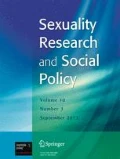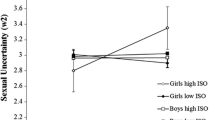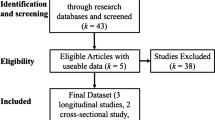Abstract
The aim of this study was to examine how young people are intentionally or unintentionally exposed to sexual material on the internet. A sample from the EU Kids Online II project, including youth (N = 11,712, 11–16 years, 50 % girls) from 25 countries, was used to examine predictors of unintentional exposure to online sexual material (EOSM) via pop-up images and intentional EOSM on adult/X-rated websites. Using a multilevel analysis, we considered several individual-level predictors (psychosocial characteristics, patters of internet use, and parental mediation), one country-level predictor (mean cultural liberalism of the country), and cross-level interactions. Except for gender, the study did not identify any specific patterns of individual-level predictors for unintentional and intentional EOSM: age, sensation seeking, sexual intercourse, amount of time spent online, level of digital skills, and degree of restrictive mediation predicted both types of EOSM. Intentional EOSM was more often reported by boys, while unintentional EOSM occurred to a similar degree among boys and girls. Finally, living in a country with a stronger culture of liberalism predicted a greater likelihood of intentional but not unintentional EOSM and also was associated with smaller gender differences in intentional EOSM.
Similar content being viewed by others
References
Ashton, M. C., Danso, H. A., Maio, G. R., Esses, V. M., Bond, M. H., & Keung, D. K. Y. (2005). Two dimensions of political attitudes and their individual difference correlates: A cross- cultural perspective. In R. M. Sorrentino, D. Cohen, J. M. Olson, & M. P. Zanna (Eds.), Culture and social behavior, Ontario symposia on personality and social psychology (pp. 1–29). NJ: Erlbaum.
Bakardjieva, M. (2005). Internet society: the internet in everyday life. London: Sage.
Bleakley, A., Hennessy, M., Fishbein, M., & Jordan, A. (2008). It works both ways: the relationship between exposure to sexual content in the media and adolescent sexual behavior. Media Psychology, 11(4), 443–461. doi:10.1080/15213260802491986.
Bronfenbrenner, U. (1979). Contexts of child rearing: problems and prospects. American Psychologist, 34(10), 844–850. doi:10.1037/0003-066X.34.10.844.
Brown, D. J., & L'Engle, L. K. (2009). X-rated: sexual attitudes and behaviors associated with U.S. Early adolescents' exposure to sexually explicit media. Communication Research, 36(1), 129–151. doi:10.1177/0093650208326465.
Children's Commissioner (2013). Basically…Porn is everywhere. Available at http://www.childrenscommissioner.gov.uk/content/press_release/content_505
Clement, U., Schmidt, G., & Kruse, M. (1984). Changes in sex differences in sexual behavior: a replication of a study on west German students (1966–1981). Archives of Sexual Behavior, 13(2), 99–120.
Daneback, K., & Löfberg, C. (2011). Youth, sexuality and the internet: Young people's use of the internet to learn about sexuality. In E. Dunkels, G.-M. Frånberg, & C. Hällgren (Eds.), Youth culture and net culture: online social practices (pp. 190–206). Hershey: IGI.
Daneback, K., Månsson, S.-A., Ross, M. W., & Markham, C. (2012). The internet as a source of information about sexuality. Sex Education, 12, 583–598. doi:10.1080/14681811.2011.627739.
European Values Study (2008). Retrieved May 14, 2012, from www.europeanvaluesstudy.eu/.
Garmendia, M., Garitaonandia, C., Martínez, G., & Casado, M. A. (2012). The effectiveness of parental mediation. In S. Livingstone, L. Haddon, & A. Görzig (Eds.), Children, risk and safety on the internet: research and policy challenges in comparative perspective (pp. 231–244). Bristol: The Policy Press.
Guerra, V. M., & Gouveia, V. V. (2007). Liberalismo/conservadorismo sexual: proposta de umamedidamulti-fatorial [sexual liberalism/conservatism: proposal of a multi-factorial measurement]. Psicologia: Reflexaão e Crítica, 20(1), 43–53. doi:10.1590/S0102-79722007000100007.
Guo, G., & Zhao, H. (2000). Multilevel modeling for binary data. Annual Review of Sociology, 26, 441–462.
Hofstede, G. (1980). Motivation, leadership, and organization: do American theories apply abroad. Organizational Dynamics, 9(1), 42–63.
Hox, J. (2000). Multilevel analysis: techniques and applications. Mahwah: Erlbaum.
Hoyle, R. H., Stephenson, M. T., Palmgreen, P., Lorch, E. P., & Donohew, R. L. (2002). Reliability and validity of a brief measure of sensation seeking. Personality and Individual Differences, 32, 401–414. doi:10.1016/S0191-8869(01)00032-0.
Ipsos/EU Kids Online (2011). EU Kids Online II: Technical report. London, LSE: EU Kids Online. Retrieved January 6, 2012, from http://www2.lse.ac.uk/media@lse/research/EUKidsOnline/EUKidsII%20(2009-11)/Survey/Technical%20report.PDF.
Kalmus, V., & Roosalu, T. (2012). Institutional filters on children's internet use: An additional explanation of cross-national differences in parental mediation. In M. Walrave, W. Heirman, S. Mels, C. Timmerman, & H. Vandebosch (Eds.), e-Youth: balancing between opportunities and risks (pp. 235–250). Brussels: Lang.
Kirwil, L. (2009). Parental mediation of children's internet use in different European countries. Journal of Children and Media, 3, 394–409. doi:10.1080/17482790903233440.
Kutchinsky, B. (1991). Pornography and rape: theory and practice? Evidence from crime data in four countries where pornography is easily available. International Journal of Law and Psychiatry, 14(1–2), 47–64.
Livingstone, S. (2007). UK children go online: balancing the opportunities against the risks. 10. Media@lse, London, UK.
Livingstone, S., & Haddon, L. (2012). Theoretical framework for children's internet use. In S. Livingstone, L. Haddon, & A. Goerzig (Eds.), Children, risk and safety online: research and policy challenges in comparative perspective (pp. 1–14). Bristol: The Policy Press.
Livingstone, S., & Helsper, E. (2008). Parental mediation and children's internet use. Journal of broadcasting & electronic media, 52, 581–599. doi:10.1080/08838150802437396.
Livingstone, S., & Helsper, E. J. (2010). Balancing opportunities and risks in teenagers' use of the internet: the role of online skills and family context. New Media & Society, 12(2), 309–329. doi:10.1177/1461444809342697.
Livingstone, S., Haddon, L., Görzig, A., & Ólafsson, K. (2011). Risks and safety on the internet: the perspective of European children. Full findings. London: EU Kids Online, LSE.
Livingstone, S., Haddon, L., Görzig, A., & Ólafsson, K. (2012). EU kids online. London: EU Kids Online, LSE.
Lo, V.-H., & Wei, R. (2005). Exposure to internet pornography and Taiwanese adolescents' sexual attitudes and behavior. Journal of Broadcasting & Electronic Media, 49(2), 221–237. doi:10.1207/s15506878jobem4902_5.
Löfgren-Mårtenson, L., & Månsson, S.-A. (2010). Lust, love, and life: a qualitative study of Swedish adolescents' perceptions and experiences with pornography. Journal of Sex Research, 47, 568–579. doi:10.1080/00224490903151374.
Lottes, I. L., & Alkula, T. (2011). An investigation of sexuality-related attitudinal patterns and characteristics related to those patterns for 32 European countries. Sexuality Research and Social Policy, 8(2), 77–92.
Maio, G. R., Olson, J. M., Bernard, M. M., & Luke, M. A. (2003). Ideologies, values, attitudes, and behavior. In J. Delamater (Ed.), Handbook of social psychology (pp. 283–308). New York: Kluwer-Plenum.
Markham, C. M., Lormand, D., Gloppen, K. M., Peskin, M. F., Flores, B., Low, B., et al. (2010). Connectedness as a predictor of sexual and reproductive health outcomes for youth. Journal of Adolescent Health, 46(3), S23–S41. doi:10.1016/j.jadohealth.2009.11.214.
Mesch, G. (2009). Social bonds and internet pornographic exposure among adolescents. Journal of Adolescence, 32, 601–618. doi:10.1016/j.adolescence.2008.06.004.
Mitchell, K. J., Finkelhor, D., & Wolak, J. (2003). The exposure of youth to unwanted sexual materials on the internet: a national survey of risk, impact and prevention. Youth & Society, 34, 330–358. doi:10.1177/0044118X02250123.
Owens, E. W., Behun, R. J., Manning, J. C., & Reid, R. C. (2012). The impact of internet pornography on adolescents: a review of the research. Sexual Addiction & Compulsivity, 19(1–2), 99–122.
Peter, J., & Valkenburg, P. M. (2006). Adolescents' exposure to sexually explicit material on the internet. Communication Research, 33, 178–204. doi:10.1177/0093650205285369.
Raudenbush, S., Bryk, A., Cheong, Y. F., Congdon, R., & du Toit, M. (2004). HLM 6: linear and nonlinear modeling. Lincolnwood: Scientific Software.
Schwartz, S. H. (2004). Are there universal aspects in the structure and contents of human values? Journal of Social Issues, 50, 19–54. doi:10.1111/j.1540-4560.1994.tb01196.x.
Ševčíková, A., & Konečný, Š. (2011). An exploration of the relationship between real-world sexual experience and online sexual activity among 17 year old adolescents. Cyberpsychology: Journal of Psychosocial Research on Cyberspace 5(1). Retrieved May 14, 2012, from http://cyberpsychology.eu/view.php?cisloclanku=2011062702&article=3.
Ševčíková, A., Simon, L., Daneback, K., & Kvapilík, T. (2012a). Bothersome exposure to online sexual content among adolescent girls. Youth & Society. doi:10.1177/0044118X12469379.
Ševčíková, A., Šeřek, J., & Macháčková, H. (2012b). Exposure to online sexual materials and cross-country differences. In M. Strano, H. Harchovec, F. Sudweeks, & C. Ess (Eds.), Proceedings eighth international conference on cultural attitudes towards technology and communication (pp. 502–513). Murdoch: Murdoch University.
Smith, M. (2013). Youth viewing sexually explicit material online: addressing the elephant on the screen. Sexuality Research and Social Policy, 10(1), 62–75. doi:10.1007/s13178-012-0103-4.
Staksrud, E., & Livingstone, S. (2009). Children and online risk: powerless victims or resourceful participants? Information, communication and society, 12, 364–387. doi:10.1080/13691180802635455.
Stephenson, M. T., Hoyle, R. H., Palmgreen, P., & Slater, M. D. (2003). Brief measures of sensation seeking for screening and large-scale surveys. Drug and Alcohol Dependence, 72, 279–286. doi:10.1016/j.drugalcdep.2003.08.003.
Valkenburg, P. M., & Peter, J. (2013). The differential susceptibility to media effects model. Journal of Communication, 63(2), 221–243.
Wolak, J., Mitchell, K. J., & Finkelhor, D. (2007). Unwanted and wanted exposure to online pornography in a national sample of youth internet users. Pediatrics, 119, 247–257. doi:10.1542/peds.2006-1891.
Wright, P. J. (2011). Mass media effects on youth sexual behavior: assessing the claim for causality. Communication Yearbook, 35, 343–386.
Ybarra, M. L., & Mitchell, K. (2005). Exposure to internet pornography among children and adolescents: a national survey. CyberPsychology & Behavior, 8(5), 473–486. doi:10.1089/cpb.2005.8.473.
Ybarra, M. L., Finkelhor, D., Mitchell, K. J., & Wolak, J. (2009). Associations between blocking, monitoring, and filtering software on the home computer and youth-reported unwanted exposure to sexual material online. Child Abuse & Neglect, 33(12), 857–869. doi:10.1016/j.chiabu.2008.09.015.
Zimmer-Gembeck, M. J., & Collins, W. A. (2003). Autonomy development during adolescence. In G. R. Adams & M. Berzonsky (Eds.), Blackwell handbook of adolescence (pp. 175–204). Oxford: Blackwell.
Acknowledgments
Data collection of the ‘EU Kids Online’ network was funded by the EC (DG Information Society) Safer Internet Plus Programme (project code SIP-KEP-321803); this work was also supported by the Czech Science Foundation (GAP407/11/0585), the Faculty of Social Studies, Masaryk University, and by the VITOVIN project (CZ.1.07/2.3.00/20.0184), which is co-financed by the European Social Fund and the state budget of Czech Republic.
Author information
Authors and Affiliations
Corresponding author
Rights and permissions
About this article
Cite this article
Ševčíková, A., Šerek, J., Barbovschi, M. et al. The Roles of Individual Characteristics and Liberalism in Intentional and Unintentional Exposure to Online Sexual Material Among European Youth: A Multilevel Approach. Sex Res Soc Policy 11, 104–115 (2014). https://doi.org/10.1007/s13178-013-0141-6
Published:
Issue Date:
DOI: https://doi.org/10.1007/s13178-013-0141-6




